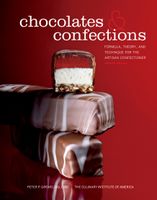Label
All
0
Clear all filters
🔥 Celebrate new books on our BBQ & Grilling shelf with 25% off ckbk membership 🔥
Divinity
Appears in
By Peter Greweling and Culinary Institute of America
Published 2007
Like fudge, divinity is a genuinely American confection; its roots go back to early twentieth-century America. Divinity is best described as a hybrid of nougat and marshmallow, with some of the characteristics of each. Like marshmallow, divinity is softer and lighter than nougat, containing both more moisture and more air than typical nougat. Like nougat, divinity is aerated using albumen. It contains less moisture than marshmallow and no gelatin. As a result, divinity is shorter textured but slightly firmer than marshmallow, and is lighter and softer than most nougat. Divinity is sometimes called seafoam or divinity fudge, the latter name being accurate when the divinity is crystallized through the introduction of fondant or another type of seed after whipping, as is commonly done. Divinity frequently contains pecans or walnuts and is often spooned into quenelles or kisses, but it may be spread into a slab and cut. It is seldom enrobed; it is usually consumed unadorned.
Part of
Advertisement
Related Recipes
-
-
-
-
Related Reference
-
-
-
-
Advertisement
The licensor does not allow printing of this title




